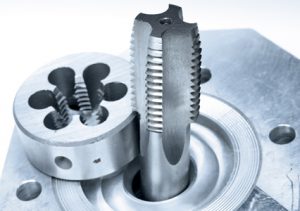[breadcrumb]
How Can a Job and Die Setter Get Mesothelioma by Occupational Exposure to Asbestos?
Job and die setters set up forging machines and align and bolt dies to ram and anvil of presses and hammers in accordance with specifications. They heat up metal to convert it to tools, small car parts, gears, stamps and other items. These workers are employed in industrial settings.
These workers work directly with metal. Many metals objects once contained asbestos. When die setters drilled holes in metal, asbestos dust could become dislodged and asbestos fibers could enter the air that workers would breathe in. Machines they worked with may have also contained asbestos insulation that might break off into microscopic fibers that they could breathe in.
Job and die setters worked with hot liquids and wore protective clothing to prevent burns. However, this protective clothing often contained asbestos before the 1980s due to its strong insulation characteristics. Workers who tried to protect themselves with protective aprons, coveralls and gloves may have inadvertently been exposing themselves to asbestos.
Common job duties of these workers include:
- Set up forging machines including forging presses, forging rolls, drophammers, coining presses and upsetters
- Aligns and bolts dies to ram and anvil of presses and hammers
- Install impression and gripping dies on upsetting machines
- Set and bolt roll dies into self-positioning slots or dogs on roll shafts of forging rolls
- Algin and bolt positioning fixtures and stops
- Turn handles to synchronize conveyor speed
- Inspect machines
- Use hand tools and measuring instruments, including squares, gauges and rules
Locations in the United States for the Highest Employment Rates for Job and Die Setters
According to the U.S. Bureau of Labor Statistics, there are 1,073,900 workers employed in the classification of “metal and plastic machine workers,” which includes roughly 72,000 die setters. States with the highest employment level for this classification of workers include:
- Michigan
- Ohio
- Illinois
- Indiana
- Pennsylvania
Similar Occupations as Job and Die Setters
Similar occupations as die setters include:
- Assemblers
- Fabricators
- Industrial machinery mechanics
- Machinery maintenance workers
- Machinists
- Metal and plastic machine workers
- Painting and coating workers
- Press machine setters, operators and tenders
- Sheet metal workers
- Tool and die makers
- Welders, cutters, solderers and brazers
Lawsuits and Settlements Involving Job and Die Setters and Mesothelioma
While there are not many cases involving job and die setters who have filed claims based on asbestos exposure that have been made public, job and die setters who were exposed to asbestos may have a variety of legal options. They may be able to file a workers’ compensation claim for medical expenses and partial wage replacement benefits. Another option may be to file a claim with a trust set up by the manufacturers of asbestos products that they were exposed to. Finally, injured workers may sue the manufacturer of asbestos products they were exposed to. They may enter into a settlement agreement with these companies prior to trial and may be required to keep any settlement they receive confidential.
Studies Related to Job and Die Setters and Asbestos
While there have not been many studies related to job and die setters in particular, there have been several studies conducted on workers in metal product factories and similar settings. For example, a 2015 British Medical Journal study analyzed the data concerning asbestos-related deaths in Belgian workers that occurred between 2001 and 2009. Researchers found that metal product factory workers were 87% more likely to die of mesothelioma than members of the general population.
A 1983 study explored the connection between asbestos and cancer deaths among machinists and found that machinists have a high risk of developing mesothelioma due to their occupational exposure to asbestos. Job and die setters work around similar products and machinery as this group of workers.
A Sheet Metal Occupational Health Institute Trust study found that 32% of union workers in the sheet metal industry between 1986 and 1990 had specific lung abnormalities that were consistent with occupational lung disorders.
Another study assessed date regarding factory workers at a Raybestos Manhattan plant who manufactured various asbestos-containing friction parts that contained asbestos. Researchers identified seven cases of mesothelioma arose due to occupational exposure during the limited time period of review.
Types of Asbestos Products Used by Job and Die Setters
Job and die setters may have come into contact with a variety of products that contained asbestos. They may have worked with metal sheets, tools or machinery that had asbestos in them. Paint, texture and spray-on coatings were also often used on metal products that job and die setters may have come in contact with. These workers may have been exposed to asbestos from the protective clothing they used, such as helmets, aprons, coveralls, shields, masks, jackets and gloves.
Job and die setters worked in factories where asbestos was used to construct the building. Asbestos may have been present in:
- Boilers
- Bricks
- Cement
- Flooring tiles
- Insulation
- Roofing materials
Manufacturers of Asbestos Products Used by Job and Die Setters
Some asbestos manufacturers that made products job and die setters may have come in contact with include:
- BF Goodrich
- Garlock Sealing Technologies
- Honeywell
- John Crane
- Johns Manville
- Pneumo Abex
- Raybestos
- Turner & Newall

